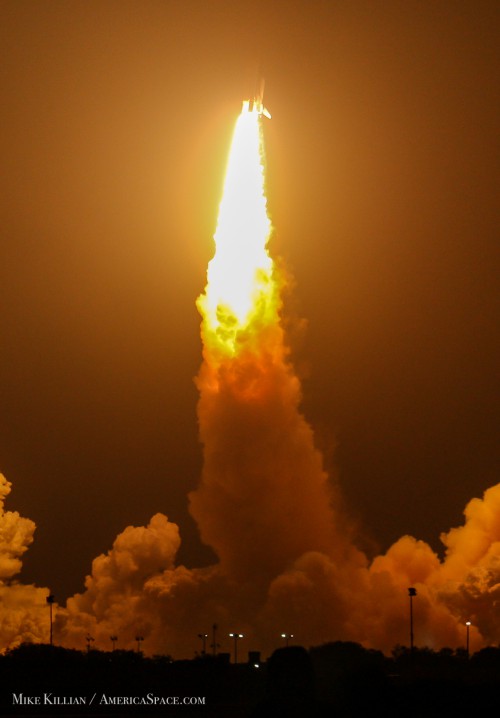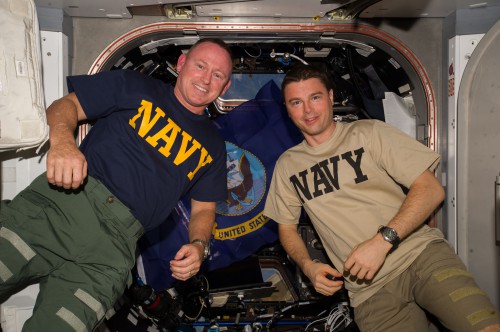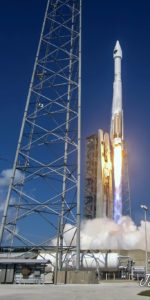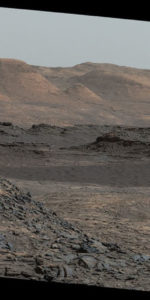
The incumbent Expedition 45 crew of the International Space Station (ISS)—Commander Scott Kelly of NASA, Russian cosmonauts Mikhail Kornienko, Oleg Kononenko, and Sergei Volkov, U.S. astronaut Kjell Lindgren, and Japan’s Kimiya Yui—continues to function normally, just a matter of days after one of eight power channels on the expansive Integrated Truss Structure (ITS) went down on Friday, 13 November.
“Channel 1B,” one of the two power channels aboard the S-6 truss, is believed to have fallen victim to a power short, which tripped its Direct Current Switching Unit (DCSU). The cause has been traced to the failure of the channel’s Sequential Shunt Unit (SSU), for which a replacement is expected to be launched and installed in 2016. Parallels have been drawn with a similar SSU failure in May 2014, on Channel 3A aboard the S-4 truss, which was later replaced by Expedition 41 spacewalkers Reid Wiseman and Barry “Butch” Wilmore. It is understood that, since Friday’s incident, the station has lost some systems redundancy, but that normal operations for the crew have been unaffected.

Originally planned to launch aboard Atlantis on STS-119 in January 2004—on the second-to-last shuttle mission before “U.S. Core Complete”—the 31,060-pound (14,090-kg) S-6 segment was intended to occupy the farthest-outboard position on the starboard side of the football-field-sized ITS as its 11th and final piece. However, following the loss of Columbia in February 2003, the shuttle fleet was grounded for more than two years and NASA re-manifested S-6 to fly somewhat later in the ISS assembly sequence, after the arrival of Europe’s Columbus and Japan’s Kibo modules.
Eventually, the final piece of the ITS rose to orbit aboard Discovery in March 2009 and was installed onto the station during a combined EVA/robotics operation involving the STS-119 and Expedition 18 crews.
The S-6 truss houses the fourth and final pair of U.S.-built Solar Array Wings (SAWs)—dubbed Power Channels “1A” and “1B”—each of which measures 115 feet (35 meters) long and 38 feet (11.6 meters) wide, when fully deployed, as well as a Beta Gimbal Assembly (BGA), whose critical components include the 186-pound (84-kg) Sequential Shunt Units (SSUs) to regulate the power generated by the arrays at an established “set-point” of 160 volts, by shunting and unshunting 82 array “strings” to ensure steady output across the ISS.
With over 65,000 solar cells in Channels 1A and 1B, a Power Generation Capability of close to 66 kilowatts is achievable, of which 21-30 kilowatts is classified as Usable Power Capability, including on-board science. This power is routed to S-6’s Integrated Equipment Assembly (IEA) for control, storage, and distribution. Primary and secondary distribution, together with protection and fault-isolation, is provided by two Direct Current Switching Units (DCSUs), each measuring 25 inches (63.5 cm) x 40 inches (101.6 cm) x 14 inches (35.5 cm) and weighing 218 pounds (98.9 kg). During orbital sunlight, the DCSUs route primary power directly to the station from the SAWs and to the power storage system for battery charging and subsequent use during periods of eclipse.
Last Friday (13 November), at 1 p.m. EST, the DCSU supporting Channel 1B on the S-6 truss suddenly tripped, due to a power short in its SSU, and it is expected that flight controllers at the Mission Control Center (MCC) at the Johnson Space Center (JSC) in Houston, Texas, will require several days to fully diagnose the problem and develop a recovery plan. According to Spaceflight101, the trip “was the result of a short circuit, upstream of the DCSU, likely within the Sequential Shunt Unit,” which performed as intended and cut power in order to protect downstream equipment from damage. Meanwhile, Channel 1B power was shunted in order avoid feeding it into a shorted system. “We were recovered from the 1B channel loss within two hours last Friday,” NASA’s Rob Navias told AmericaSpace earlier today (Tuesday, 18 November), “thanks to fault-detection software that tied the systems fed by the 1B channel to the 1A and 4A channels.”
It was added that there were “no impacts, no danger to the crew” and none of the Twitter-savvy members of Expedition 45 have mentioned the incident. In fact, the sole mention by NASA came yesterday (Monday, 16 November), as the crew observed a minute’s silence in honor of those killed in last week’s terrorist atrocity in Paris. “Engineers continued to troubleshoot systems after one of the eight station power channels went down last Friday,” it was reported. “There were no impacts on crew activities, the station maintained orbital control and communications remained in good condition. Ground teams are discussing future repair plans and are currently able to manage the power balance for the foreseeable future.” In terms of systems affected, Mr. Navias told AmericaSpace that NASA “cannot account for every system,” but stressed that “nothing significant was affected, even for a short time.” Current electrical loads across the U.S. Orbital Segment (USOS) are being carried with the remaining seven power channels—1A, 2A, 2B, 3A, 3B, 4A, and 4B—which are provided by the SAWs affixed to the S-6, P-6, S-4, and P-4 truss segments. “We have, for the moment, decided we are fine with seven of eight power channels carrying all loads,” explained Mr. Navias. “No specific forward plan has been identified, but ultimately we will need to fly a spare SSU to the station to replace the failed 1B SSU.”

Interestingly, this is not the first occasion that an SSU short has tripped a DCSU and caused a power channel to go down. Back in September 2012, an overcurrent in a Remote Bus Isolator (RBI) inside the DCSU on the S-4 truss precipitated the loss of Channel 3A. After several weeks of monitoring, it was recognized that the SSU remained fully functional and the RBI was closed, thus restoring the power channel without the need for spacewalkers to perform an EVA. However, on 8 May 2014, the same RBI tripped open, “due to a negative current condition.” It was noted by NASA that the DCSUs for Channels 3A and 3B on the S-4 truss were tied together, with all power loads successfully recovered, although several payloads did temporarily lose power. This included a brief suspension of science operations for the Optical Payload for Lasercomm Science (OPALS) and the Alpha Magnetic Spectrometer (AMS)-2, together with Robotic systems and cooling for S-4’s Photovoltaic Thermal Control System (PVTCS), and effectively left the ISS running on seven of its eight power channels.
According to Spaceflight101 at the time, the trip “was associated with a sharp temperature increase … and a high current difference between the two SSU circuits that was six times higher than normal.” Unlike the previously successful “remote” recovery effort, it became readily apparent that an EVA would be necessary to remove and replace the SSU. Under original plans, Expedition 40 astronauts Steve Swanson and Reid Wiseman would have performed U.S. EVA-27 in August 2014 to complete this activity, but their spacewalk was postponed in the wake of problems with Long Life Batteries (LLBs) in the U.S. Extravehicular Mobility Unit (EMU) suits. Not until 15 October did U.S. EVA-27 eventually take place, featuring Wiseman and his newly-arrived Expedition 41 crewmate, Barry “Butch” Wilmore, who successfully removed and replaced the failed SSU.
In a sense, the current situation with Channel 1B and the failure of the SSU as its root cause creates a parallel with last year’s Channel 3A event. Spaceflight101 reported shortly after Friday’s failure that electrical loads were tied from the Channel 1B to 1A, “which can carry additional loads without issue, allowing essential systems to be operated,” but that although the current situation of having one channel down “is far from critical,” the recovery effort will be executed “in a timely manner,” due to the loss of redundancy. Spaceflight101 has noted that two elements of the Environmental Control and Life Support System (ECLSS) aboard the Tranquility node—the Common Cabin Air Assembly (CCAA), which collects condensate from the station’s atmosphere, and the Oxygen Generator Assembly (OGA), which converts water from the Water Processor Assembly (WPA) into oxygen by means of electrolysis—were briefly affected, as well as crew audio-terminal units.
Be sure to “Like” AmericaSpace on Facebook and follow us on Twitter: @AmericaSpace
.






2 Comments
2 Pings & Trackbacks
Pingback:Kopra and Peake Primed for Friday Spacewalk « AmericaSpace
Pingback:US and UK Spacewalkers Repair, Replace, Remove and Install Hardware Outside Space Station « AmericaSpace